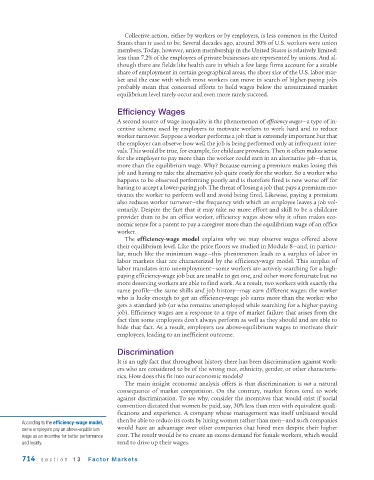Page 756 - Krugmans Economics for AP Text Book_Neat
P. 756
Collective action, either by workers or by employers, is less common in the United
States than it used to be. Several decades ago, around 30% of U.S. workers were union
members. Today, however, union membership in the United States is relatively limited:
less than 7.2% of the employees of private businesses are represented by unions. And al-
though there are fields like health care in which a few large firms account for a sizable
share of employment in certain geographical areas, the sheer size of the U.S. labor mar-
ket and the ease with which most workers can move in search of higher-paying jobs
probably mean that concerted efforts to hold wages below the unrestrained market
equilibrium level rarely occur and even more rarely succeed.
Efficiency Wages
A second source of wage inequality is the phenomenon of efficiency wages—a type of in-
centive scheme used by employers to motivate workers to work hard and to reduce
worker turnover. Suppose a worker performs a job that is extremely important but that
the employer can observe how well the job is being performed only at infrequent inter-
vals. This would be true, for example, for childcare providers. Then it often makes sense
for the employer to pay more than the worker could earn in an alternative job—that is,
more than the equilibrium wage. Why? Because earning a premium makes losing this
job and having to take the alternative job quite costly for the worker. So a worker who
happens to be observed performing poorly and is therefore fired is now worse off for
having to accept a lower-paying job. The threat of losing a job that pays a premium mo-
tivates the worker to perform well and avoid being fired. Likewise, paying a premium
also reduces worker turnover—the frequency with which an employee leaves a job vol-
untarily. Despite the fact that it may take no more effort and skill to be a childcare
provider than to be an office worker, efficiency wages show why it often makes eco-
nomic sense for a parent to pay a caregiver more than the equilibrium wage of an office
worker.
The efficiency-wage model explains why we may observe wages offered above
their equilibrium level. Like the price floors we studied in Module 8—and, in particu-
lar, much like the minimum wage—this phenomenon leads to a surplus of labor in
labor markets that are characterized by the efficiency-wage model. This surplus of
labor translates into unemployment—some workers are actively searching for a high-
paying efficiency-wage job but are unable to get one, and other more fortunate but no
more deserving workers are able to find work. As a result, two workers with exactly the
same profile—the same skills and job history—may earn different wages: the worker
who is lucky enough to get an efficiency-wage job earns more than the worker who
gets a standard job (or who remains unemployed while searching for a higher-paying
job). Efficiency wages are a response to a type of market failure that arises from the
fact that some employees don’t always perform as well as they should and are able to
hide that fact. As a result, employers use above-equilibrium wages to motivate their
employees, leading to an inefficient outcome.
Discrimination
It is an ugly fact that throughout history there has been discrimination against work-
ers who are considered to be of the wrong race, ethnicity, gender, or other characteris-
tics. How does this fit into our economic models?
The main insight economic analysis offers is that discrimination is not a natural
consequence of market competition. On the contrary, market forces tend to work
against discrimination. To see why, consider the incentives that would exist if social
convention dictated that women be paid, say, 30% less than men with equivalent quali-
fications and experience. A company whose management was itself unbiased would
then be able to reduce its costs by hiring women rather than men—and such companies
According to the efficiency-wage model,
some employers pay an above-equilibrium would have an advantage over other companies that hired men despite their higher
wage as an incentive for better performance cost. The result would be to create an excess demand for female workers, which would
and loyalty. tend to drive up their wages.
714 section 13 Factor Markets

